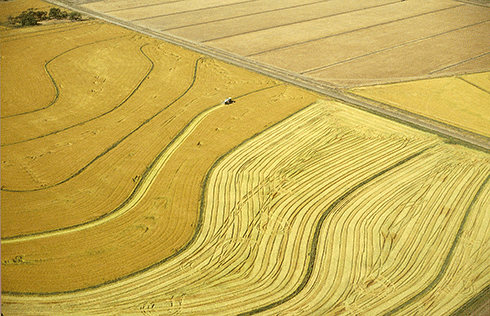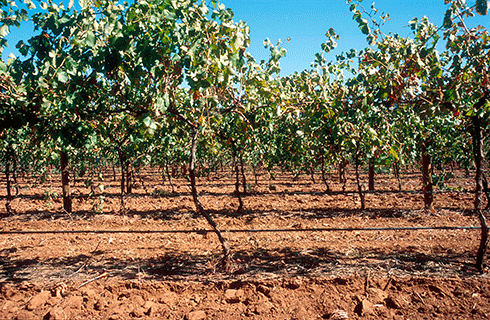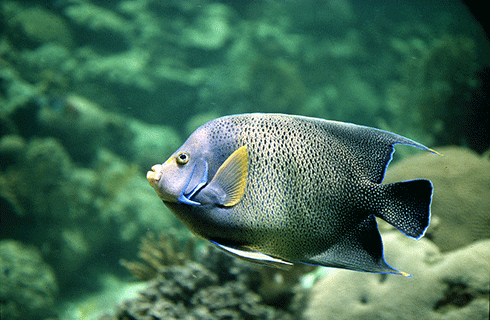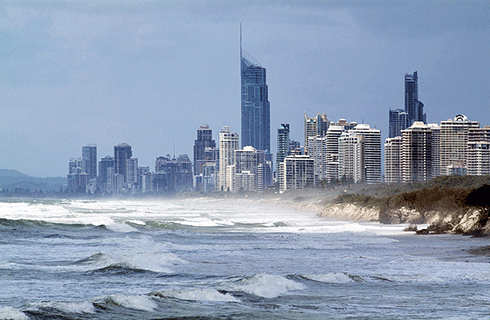
|
Published: 7 April 2014
Adapting to climate change: window of opportunity closing fast but options still open
Last week, the Intergovernmental Panel on Climate Change (IPCC) Working Group II released its Fifth Assessment Report , which focuses on the vulnerability of natural systems to climate change, the impacts of this change, and adaptation options. While the issue received a fair bit of media coverage last week, here is a roundup of insights from five CSIRO researchers, all lead authors of the report, on how humanity can best adapt to the change.

|
|
Rice harvesting in the Murrumbidgee catchment: climate adaptation could see this farming industry move from south-eastern Australia to the Northern Territory. Credit: W Aken/scienceimage
|
‘The external environment in which we are operating has changed,’ says CSIRO scientist and IPCC report veteran Dr Mark Howden.
‘The average temperatures and rainfalls have changed, and in some circumstances that warrants a change in our goals and also the way we achieve those goals. It’s changing what we do to get what we want.’
As he points out, adaptation is the process of adjusting those goals and developing strategies to help reduce the impacts of climate change on ecosystems and communities.
‘In most cases, there is still a range of options that people can pursue,’ he says.
Helping farmers adapt to drier conditions
Dr Howden is a lead author on the food security chapter, a contributing author on the Australasian chapter, and part of the IPCC Synthesis Report core writing team. As an expert on climate change and agriculture, he works with rural industries to help them adapt to Australia’s changing climate.
‘There’s evidence that the changes we’ve already seen in terms of climate change are having impacts on food production and food security, and that these changes are likely to increase very significantly over the next decade,’ he says.
Adaptation strategies can take different forms. Incremental adaptation involves minor adjustments, such as changes to crop variety for hotter conditions. Then there are systemic changes. For instance, reductions in rainfall make conditions more marginal for cropping, but more appropriate for grazing. So integrating grazing with cropping is another strategy.
Transformational change involves swapping from a cropping system entirely to a grazing system, or moving to a different environment to continue cropping. Dr Howden says an example of this could be a farmer in Murrumbidgee in south-east Australia moving to the Northern Territory to grow rice.
Farmers have a history of adapting to change. And with climate variability, more flexible farming systems are likely to be an advantage.
Credit: CSIRO
Managing water supplies
Dr Francis Chiew is a CSIRO scientist and water expert, and lead author on the Australasian chapter.
‘One of the biggest things we need to respond to is the drying trend in Australia,’ he says. ‘The drying trend that we’ve seen in the far south-west and south-eastern Australia is associated mainly with a drier winter, when most of the runoff in southern Australia occurs.’
Dr Chiew says freshwater resources in far south-eastern and south-west Australia are projected to decline by up to 40 per cent and 20–70 per cent, respectively, because of a decline in winter rainfall. The range is wide because of uncertainties in future rainfall projections.
The CSIRO is providing water agencies with sophisticated climate and water modelling, to help them develop water management options.
Adaptation in cities focuses on securing new supplies that are more resilient to climate shocks, increasing the use of alternative sources like sewerage recycling and storm water for non-potable water, and incentives to reduce water use.
In rural areas, water reforms include purchasing water entitlements for environmental use, upgrading water infrastructure, improving water use efficiency, allocation and trading, and developing flexible water sharing and management plans.
‘Although these adaptation measures are driven by climate change, they are also driven by other factors like population growth in cities and equitable sharing of water between irrigation and the environment in regional areas’ Dr Chiew says.

|
|
Drip irrigation at a South Australian vineyard: with less rain predicted for southern Australia, farmers will need to be more efficient in using irrigation water. Credit: G Rinder/scienceimage
|
Preserving the ocean and ecosystems
CSIRO scientist Dr Elvira Poloczanska is a lead author of the ocean chapter of the IPCC report.
She points out that the ocean is very important for human welfare, through the provision and transportation of food and other resources, and providing cultural and economic benefits.
The ocean also provides vital services such as regulation of atmospheric gases and the distribution of heat across the planet. But more than 90 per cent of the extra energy from the enhanced greenhouse effect and 30 per cent of anthropogenic carbon dioxide has been absorbed by the ocean, resulting in warming and ocean acidification. This will have significant impacts on ecosystems and coastal communities.
The CSIRO has been developing partnerships with different organisations and industries to explore adaptation activities such as building ecological resilience, and providing vulnerability and risk assessments.
Dr Penny Whetton, another lead author on the report’s Australasian chapter, says natural ecosystems have already had to adapt to changing climates. As the climate warms, plants and animals find that their preferred climatic conditions may no longer occur where they are living. Some may be able to migrate, for example, to find more conducive conditions.

|
|
Ocean warming will see more tropical species along the eastern and western coasts of Australia migrating southward. Credit: Robert Kerton/scienceimage
|
But adaptive responses by entire ecosystems can be more problematic. For instance, Dr Whetton says, a warming of 1.5°C in the next 30–40 years poses a risk to coral reefs that could significantly change their structure.
Dr Poloczanska says the changing climate will likely affect fishing, too. ‘People wanting to catch fish may not find them in locations where they previously occurred. So if they want to maintain fisheries in that region, they may need to change what they fish for.’
According to Dr Howden, in the oceans off south-east Australia, many species from further north are appearing in Tasmanian waters. This migration is anticipated to increase in future. One adaptation option, he says, is to ensure that fishery jurisdictions and catch quotas migrate with the fish.
Protecting coastal communities
CSIRO scientist Dr Kathleen McInnes is a lead author of the chapter on coastal systems and low lying areas, and a contributing author to the Australasian chapter. Her work is on the impacts of rising sea levels, ocean warming and ocean acidity.
Dr McInnes says despite efforts to mitigate future greenhouse emissions, sea levels will continue rising for centuries because of warming from previous emissions.
‘Protective sea walls may be necessary in the long run if certain sea level rise thresholds are exceeded,’ she says.
Until that point is reached, more environmentally friendly and less costly adaptation measures may include land-use planning to increase and/or maintain a vegetated coastal margin (for example, conserving mangrove areas), which serves as a buffer zone against extreme sea levels.
Dr McInnes and her team have been modelling extreme sea levels around the Australian coastline to better understand how changes to weather patterns may alter extreme sea level risk in the future.
‘We are finding that for most regions, it is the sea level rise that will be the dominant factor for worsening the impact of storm surges in the future.
‘However changing weather patterns will also play a role in some places’ she says.
Her team has used modelling to develop inundation maps for identifying those areas most vulnerable to rising sea levels. Such maps provide information about where adaptation planning in the coastal zone is most needed.

|
|
Areas like the Gold Coast that are most vulnerable to rising sea levels will require more intensive adaptation planning. Credit: Bruce Miller/scienceimage
|
What’s coming up?
Dr Whetton is part of a team now using the latest global climate model experiments from other research centres around the world to provide updated climate change projections for Australia. The work is expected to be completed this year.
The aim of the climate projections is to support the needs of natural resource management (NRM) at regional levels.
The projections will take into account many different variables including temperature, precipitation, humidity, radiation and sea level. Extremes like very hot days and extreme rainfall will be assessed.
‘As well as being updated with the latest science, expect these projections to be the most comprehensive yet produced for Australia, and very well-tailored for application in a broad range of impact areas,’ Dr Whetton says.
Dr Mark Howden is a chief research scientist with CSIRO Ecosystem Sciences, a theme leader within the CSIRO Climate Adaptation Flagship and Honorary Professor at Melbourne University. He has worked on climate change issues for over 24 years in partnership with farmer and catchment groups, industry bodies, urban utilities and policy agencies. Mark was a major contributor to the IPCC’s Second, Third, Fourth and Fifth Assessment Reports and various IPCC Special Reports, sharing the 2007 Peace Prize with other IPCC participants and Al Gore. He sits on the US Federal Advisory Committee for the National Climate Assessment and several other science and policy advisory bodies.
Dr Kathleen McInnes leads a team at CSIRO Marine and Atmospheric Research investigating coastal impacts of extreme sea levels and how these are influenced by climate variability and future climate change. She has been a lead or contributing author of various IPCC reports, most recently Chapter 5: Coastal Systems and Low-Lying Areas in the IPCC Working Group II contribution to the Fifth Assessment Report.
Dr Penny Whetton is a senior principal research scientist with CSIRO’s Climate Adaptation Flagship. She has taken a leading role in Australian climate change scenarios released by CSIRO in 1992, 1996 and 2001, and by CSIRO and the Bureau of Meteorology in 2007. Dr Whetton was also a lead author of the regional projection chapters of Third and Fourth Assessment Reports of the IPCC and the Australasia chapter of the Fifth Assessment Report. Her research group was a recipient of a 2003 Eureka Prize.
Dr Elvira Poloczanska is a research scientist at CSIRO Marine and Atmospheric Research. She has expertise in climate change ecology, ecological modelling and coastal ecosystems and is a lead author, Chapter 30 The Ocean (regional chapter); a contributing author for Chapter 6: Ocean Systems, Chapter 18: Detection and Attribution of Observed Impacts, and Technical Summary; and a drafting author of the Summary for Policymakers.
Dr Francis Chiew leads a team of 50 surface water hydrologists at CSIRO working on catchment hydrology, hydrological modelling, climate impact on water, streamflow forecasting and integrated river basin management. He has led several national projects, including the assessment of historical and future water availability across south-eastern Australia. Francis is a lead author in the Intergovernmental Panel on Climate Change Fifth Assessment Report.
This article is republished from the CSIRO Climate Response blog.



